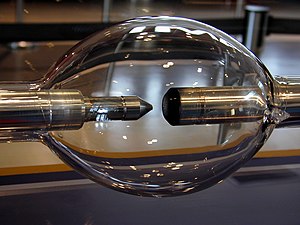Operation of Arc Lamps
– An arc is the discharge that occurs when a gas is ionized.
– A high voltage is pulsed across the lamp to ignite or strike the arc.
– The strike requires an electrical circuit with an igniter and a ballast.
– The ballast is wired in series with the lamp and limits the current to that needed to operate the lamp.
Carbon Arc Lamps
– In a carbon arc lamp, the electrodes are carbon rods in free air.
– The rods are touched together to ignite the lamp.
– Electric current heats and maintains an arc across the gap between the rods.
– The carbon vapor in the arc produces the bright light.
– The distance between the rods needs to be regularly adjusted to maintain the arc.
History of Arc Lamps
– Humphry Davy demonstrated carbon-arc lighting in the early 19th century.
– The term ‘arc lamp’ was coined by Davy.
– In the late 19th century, electric arc lighting was widely used for public lighting.
– The flickering and hissing of electric arcs were explained by Hertha Ayrton.
– The arc lamp provided one of the first commercial uses for electricity.
– Attempts to produce arc lamps commercially in the U.S. began after 1850.
– The lack of a constant electricity supply hindered early efforts.
– William Edwards Staite and Charles F. Brush improved the concept of arc lamps.
– Brush’s improved dynamo was applied to arc lighting in 1879.
– The Franklin Institute conducted a comparative test of dynamo systems in 1877.
Other Types of Arc Lamps
– Gas discharge lamps now use the term ‘arc lamp.’
– The common fluorescent lamp is a low-pressure mercury arc lamp.
– The xenon arc lamp is used in applications that formerly used the carbon arc.
– The temperature of the arc in an arc lamp can reach several thousand degrees Celsius.
– The Vortek water-wall plasma arc lamp holds the record for the most powerful continuously burning light source.
Applications and Decline of Arc Lamps
– Arc lamps were used in early motion-picture studios but produced high levels of ultra-violet light.
– Adding a sheet of ordinary window glass solved the problem of excessive ultra-violet light.
– Elmer Ambrose Sperry manufactured high-intensity carbon arc searchlights for warships.
– In the 1920s, carbon arc lamps were sold as family health products.
– Filament lamps replaced arc lamps in most roles, but arc lamps are still used in niche applications.
– Carbon arc lamps influenced the practice of shipping and projecting motion pictures on 2,000-foot reels.
– Changeovers between two projectors were necessary due to the limited lifespan of carbon rods.
– The advent of xenon projector lamps led to the disappearance of the two-projector changeover setup.
– Single-projector platter systems replaced the two-projector setup in the 1970s.
– Arc lamps are still used in cinema projection, spotlights, and searchlights. Source: https://en.wikipedia.org/wiki/Arc_lamp
An arc lamp or arc light is a lamp that produces light by an electric arc (also called a voltaic arc).



The carbon arc light, which consists of an arc between carbon electrodes in air, invented by Humphry Davy in the first decade of the 1800s, was the first practical electric light. It was widely used starting in the 1870s for street and large building lighting until it was superseded by the incandescent light in the early 20th century. It continued in use in more specialized applications where a high intensity point light source was needed, such as searchlights and movie projectors until after World War II. The carbon arc lamp is now obsolete for most of these purposes, but it is still used as a source of high intensity ultraviolet light.
The term is now used for gas discharge lamps, which produce light by an arc between metal electrodes through a gas in a glass bulb. The common fluorescent lamp is a low-pressure mercury arc lamp. The xenon arc lamp, which produces a high intensity white light, is now used in many of the applications which formerly used the carbon arc, such as movie projectors and searchlights.
